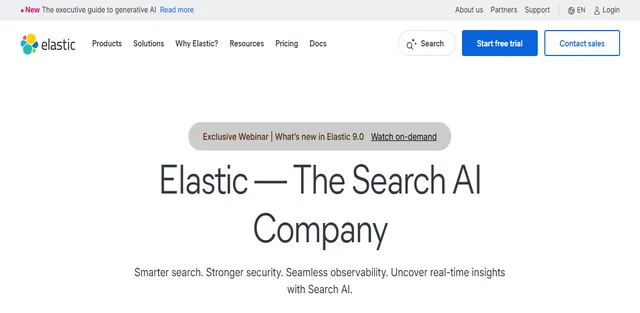
Elastic is a company that helps businesses use data better through tools for search, security, and monitoring. It’s known for Elasticsearch, a powerful search engine that’s part of the Elastic Stack, which also includes Kibana for visuals, Beats for data collection, and Logstash for processing logs. Founded in 2012, Elastic serves over 17,000 customers, including big names like Uber and Microsoft, and is traded on the NYSE as ESTC. It’s great for e-commerce, IT, and healthcare industries, focusing on real-time insights with AI and scalability.
What is Elasticsearch?
Elasticsearch is an open-source, distributed search and analytics engine built on Apache Lucene, launched in 2010. It’s designed to store, search, and analyze large volumes of data in near real-time, making it ideal for applications requiring fast and scalable search capabilities. As part of the Elastic Stack, Elasticsearch enables users to derive actionable insights from structured, unstructured, and semi-structured data, supporting full-text search, structured search, analytics, and AI-driven applications.
Key Features of Elastic
Elastic’s platform has features that make it a versatile tool for modern enterprises. Here are its key offerings, detailed for clarity:
- Advanced Search Capabilities: Enterprise search, application search, and site search.
- Generative AI: Vector database integration optimized for running Retrieval-Augmented Generation (RAG) workloads, enhancing AI applications like chatbots and content generation. AI search capabilities enable more natural and intuitive search experiences through generative AI, improving user interactions.
- Scalability and Flexibility: Cloud and on-premises options offer Elastic Cloud for managed services and on-premises solutions for greater control, catering to different business needs. Search AI Lake combines cloud-native services with object storage for boundless storage and low-latency search, ideal for large-scale data needs.
- Real-Time Data Processing: Elasticsearch, the core search engine that processes data in real-time, supporting full-text search, structured search, and analytics, making it versatile for various data types.
- Security Solutions: AI-driven security analytics detects and responds to cyber threats proactively using machine learning, modernizing security operations (SecOps). Security information and event management (SIEM) integrates with existing SIEM systems to augment security operations, helping detect threats before they cause damage.
- Observability: Unified observability provides a single platform to monitor IT infrastructure, applications, and logs, reducing the need for multiple tools. Machine learning-powered insights identify anomalies and patterns in data to accelerate problem resolution, ideal for IT teams.
These features make Elastic a comprehensive platform for businesses looking to harness the power of their data across search, security, and observability, with a strong emphasis on AI and scalability.
Use Cases for Elastic
Elastic’s versatility makes it suitable for a wide range of industries and applications. Here are some key use cases:
- E-commerce: Enhances product search to improve customer experience and increase sales, crucial for online retailers.
- IT and DevOps: Monitors application performance and infrastructure health to ensure smooth operations, reducing downtime.
- Security: Detects and mitigates cyber threats through advanced analytics and threat intelligence, modernizing security operations.
- Business Intelligence: Analyzes large datasets to derive actionable insights for decision-making, supporting data-driven strategies.
- Media and Publishing: Provides efficient content discovery and recommendation systems, enhancing user engagement on media platforms.
These use cases highlight how Elastic’s platform can be tailored to meet the specific needs of different industries, making it a valuable tool for enterprises of all sizes.
Pros and Cons of Elastic
Pros:
- Powerful search: Offers powerful search functionality, ideal for complex search needs.
- Scalable for big data: Scales easily, handle large amounts of data, perfect for growing businesses.
- Open-source foundation: Starts with open-source tools, which can save money and get community support.
- Trusted by big companies: Trusted by big companies like Netflix and Uber, showing it’s reliable.
Cons:
- Expert Knowledge Required: Hard to set up and manage, needing expert knowledge for the best results.
- Resource-Heavy: Uses a lot of system resources, especially for big setups, which can slow things down.
- Cost: Advanced features can be costly.
How to Use Elasticsearch?
To use Elasticsearch, follow these general steps:
Set Up a Cluster: Install and configure an Elasticsearch cluster, either on-premises or using a managed service like Amazon OpenSearch Service.
Index Data: Use the RESTful API to index your data into Elasticsearch.
Search Data: Use the search API to query your data.
Visualize Data: Use Kibana to create dashboards and visualizations for your data.
Monitor and Manage: Use tools like Kibana or the Elastic Stack to monitor your cluster's health, performance, and security.
What Does Elasticsearch Do?
Elasticsearch provides a wide range of functionalities, including:
-
Search: Full-text search, keyword search, semantic search, vector search, and geospatial search.
-
Analytics: Real-time data analysis, aggregation, and visualization.
-
Logging: Log collection, storage, and analysis for observability.
-
Security: Threat detection, anomaly detection, and security analytics.
-
AI: Support for machine learning models and vector databases for AI applications.
Its primary role is to make data searchable and analyzable in near real-time, enabling users to derive insights from large datasets quickly and efficiently.
Alternatives to Elastic
While Elastic is a top choice for many enterprises, some alternatives might better suit specific needs or preferences. Here’s a list of options, each with unique strengths:
Algolia:
- Focus: Search-as-a-service, especially for e-commerce and websites.
- Key Features: Real-time search, typo tolerance, and faceted search for easy filtering.
- Best For: Businesses wanting a simple, hosted search solution without managing servers.
Meilisearch:
- Focus: Open-source, self-hosted search engine.
- Key Features: Easy to set up, fast, and lightweight, perfect for small projects.
- Best For: Small to medium-sized businesses needing a straightforward search tool.
Apache Solr:
- Focus: Open-source enterprise search platform.
- Key Features: Full-text search, faceted search, and real-time indexing for large datasets.
- Best For: Organizations already using Apache tools or needing a customizable search engine.
Splunk:
- Focus: Log management and security analytics.
- Key Features: Real-time data collection, advanced analytics, and dashboard creation for monitoring.
- Best For: Enterprises focused on log management and security information event management (SIEM
Datadog:
- Focus: Observability and monitoring.
- Key Features: Application performance monitoring (APM), infrastructure monitoring, and log management in one place.
- Best For: Companies needing a user-friendly observability solution with strong support.
Each of these alternatives offers unique strengths, making them suitable for specific use cases where Elastic might not be the best fit.
Elasticsearch API
Elasticsearch provides a RESTful API for interacting with the cluster, allowing users to perform operations such as indexing data, searching, retrieving documents, and managing the cluster. The API is central to how Elasticsearch is used programmatically and supports various HTTP methods (GET, POST, PUT, DELETE) for different operations.
Elasticsearch Kibana
Kibana is a data visualization and exploration tool that is part of the Elastic Stack, tightly integrated with Elasticsearch. It allows users to create dashboards, build visualizations, and perform searches using a user-friendly interface. Key features include:
- Dashboards: Create custom dashboards with multiple visualizations to monitor data.
- Visualizations: Build charts, graphs, and maps to represent data, enhancing data exploration.
- Discover: Explore data with ad-hoc queries and filters, using KQL for simplicity.
- Machine Learning: Integrate ML jobs to detect anomalies and patterns, improving analytics.
Kibana is essential for making sense of data stored in Elasticsearch, especially for non-technical users.
Elasticsearch Open Source and Vector Search
Elasticsearch was originally open-source under the Apache License 2.0, but as of January 2021, new versions are under the Elastic License and SSPL, which are not open-source. However, older versions and forks like OpenSearch remain open source, offering users the freedom to modify and distribute the software. This change has led to some controversy, with AWS and others supporting OpenSearch as an open-source alternative.
Vector search in Elasticsearch allows for similarity searches based on vector embeddings, essential for AI applications dealing with unstructured data like text, images, or audio. It supports billions of embeddings, offering fast hybrid and vector search, making it ideal for semantic search, recommendation systems, and Retrieval-Augmented Generation (RAG) for large language models (LLMs).
 Elastic Reviews & Ratings: See What Users and Experts Are Saying
Elastic Reviews & Ratings: See What Users and Experts Are Saying
 Elastic FAQ: Learn How to Use It, Troubleshoot Issues, and More
Elastic FAQ: Learn How to Use It, Troubleshoot Issues, and More
Elastic Enterprise Search is a solution provided by Elastic that leverages Elasticsearch to power search experiences across various applications. It includes features like site search, application search, and workplace search, enabling businesses to enhance their search capabilities for customers, employees, and partners.
Elasticsearch is ideal for scenarios requiring fast, scalable search and analytics, especially for large datasets, real-time insights, and AI-driven applications. It’s particularly valuable for e-commerce, IT operations, security, and AI-driven services where traditional databases might be too slow or rigid.
Elasticsearch offers speed, scalability, flexibility, and AI capabilities, making it a top choice for modern data-driven applications.
Elastic Stack is often cheaper and open-source, while Splunk is powerful for log management but can be costly.
Elastic Stack offers more customization for search, while Datadog is user-friendly for monitoring with strong support.
Logstash is a component of the Elastic Stack, not a competitor, used for data processing within the stack.
OpenSearch is a fork of Elasticsearch, open-source, with similar features but less commercial support, leading to licensing debates.
Graylog is open-source for log management, simpler than Elastic Stack, but less scalable for large datasets.
Fluentd is a data collector like Beats, lighter for specific use cases, while Elastic Stack offers a full suite.
Fluent Bit is a lightweight data shipper, similar to Beats, but Elastic Stack includes more tools for processing and visualization.
Vector is a modern data pipeline tool, lighter than Elastic Stack, but lacks the full suite for search and visualization.
Lumberjack is an older tool, now replaced by Beats in the Elastic Stack, offering similar data collection but outdated.
Elastic provides tools for search, security, and observability, helping businesses analyze data in real-time.
Elasticsearch is a fast search engine that stores and searches data across multiple computers for quick results.
Includes Elasticsearch for search, Kibana for visuals, Beats for data collection, and Logstash for processing.
Data flows from collection (Beats) to processing (Logstash), storage (Elasticsearch), and visualization (Kibana).
Used for log analytics, security monitoring, e-commerce search, and IT operations, trusted by big companies.
Elastic is often cheaper and customizable, while Splunk is user-friendly but costly for log management.
Yes, like OpenSearch, Graylog, Fluentd, Fluent Bit, and Vector, each with specific strengths.
Core tools have open-source versions, but newer ones use commercial licenses, with forks like OpenSearch staying open.
Download and install from Elastic’s website, follow tutorials to set up and use.
Supports AI with machine learning for anomaly detection and vector search for recommendation systems.
Elasticsearch has commercial options, while OpenSearch is a fully open-source fork with similar features.
Yes, AWS offers Amazon OpenSearch Service, and Azure has Azure OpenSearch for managed setups.
Includes Elastic Agent for data collection, Elastic Security for threat detection, and Elastic Labs for experiments.














